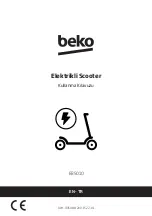
EN
139
I. Recycling
The symbol shown here and on the device means that the device is classified as electrical or
electronic equipment and must not be disposed of with other household or commercial waste at
the end of its service life.
The WEEE Directive 2012/19/EU (Waste Electrical and Electronic Equipment Directive) was
introduced to recycle appliances using the most effective recovery and recycling techniques in
order to minimise environmental impacts, treat hazardous substances and avoid increasing the
number of landfills.
Disposal instructions for private users:
Once no longer in use, dispose of the device in accordance with local recycling processes. For additional
information, contact your local authorities or dealer.
Disposal instructions for professional users:
Professional users must contact their suppliers, verify the general conditions of the purchase agreement
and ensure that this device is not mixed with other commercial waste when disposing of it.
J. Cleaning, maintenance and storage
The KICKWAY E1 requires regular maintenance. This section describes the important steps and
requirements associated with maintaining your KICKWAY E1.
I. Cleaning
• Ensure the power supply and charging cable for the KICKWAY E1 have been properly disconnected.
• Wipe your KICKWAY E1 clean using a soft, dry cloth.
WARNING:
• Your KICKWAY E1 is certified IPX4. This means it is splash resistant. However, it
should not be immersed in liquid or subjected to a water jet. Never clean the KICKWAY
E1 with high-pressure water jets and never submerge it in liquid.
• Do not allow water or other liquids to enter the KICKWAY E1 as this may cause
irreversible damage to the electronic components.
• If you do, your warranty will be voided.
• Cleaning and maintenance of the device should not be performed by unsupervised
children.
II. Maintenance
Wheel and brake system maintenance:
• Remember to apply lubricating oil regularly to both ends of the brake cable to ensure long service life
and proper operation.
• Carefully check the front and rear wheels and hub before using the scooter. The tyres must not be
damaged or punctured.
• In case of problem, contact the after-sales service to replace the tyres.
• Hardware maintenance:
• Carefully check the screws on each part before using the scooter. The screws must not be loose or too
damaged.
Note:
Check that the scooter operates normally before each use. In the event of an anomaly, do not use
the scooter and contact the after-sales service for repairs. Never modify the structure of the scooter. Any
modification may result in injury, and the manufacturer will not be liable for any consequential damage
resulting from such modifications.









































